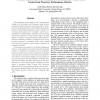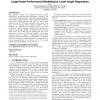HPCA
2009
IEEE
15 years 1 months ago
2009
IEEE
The shrinking processor feature size, lower threshold voltage and increasing clock frequency make modern processors highly vulnerable to transient faults. Architectural Vulnerabil...
HPCA
2009
IEEE
15 years 1 months ago
2009
IEEE
Driven by continuing scaling of Moore's law, chip multiprocessors and systems-on-a-chip are expected to grow the core count from dozens today to hundreds in the near future. ...
HPCA
2009
IEEE
15 years 1 months ago
2009
IEEE
In a Chip Multi-Processor (CMP) with private caches, the last level cache is statically partitioned between all the cores. This prevents such CMPs from sharing cache capacity in r...
HPCA
2009
IEEE
15 years 1 months ago
2009
IEEE
Network-on-Chips (NoCs) are quite latency sensitive, since their communication latency strongly affects the application performance on recent many-core architectures. To reduce th...
HPCA
2009
IEEE
15 years 1 months ago
2009
IEEE
Magnetic Random Access Memory (MRAM) is considered to be a promising future memory technology due to its low leakage power, high density and fast read speed. The heterogeneous int...
HPCA
2009
IEEE
15 years 1 months ago
2009
IEEE
The number of functional errors escaping design verification and being released into final silicon is growing, due to the increasing complexity and shrinking production schedules ...
HPCA
2009
IEEE
15 years 1 months ago
2009
IEEE
Previous studies have proposed techniques to dynamically change the architecture of a processor to better suit the characteristics of the workload at hand. However, all such appro...
DAC
2009
ACM
15 years 1 months ago
2009
ACM
In many Systems on Chips (SoCs), the cores are clustered in to voltage islands. When cores in an island are unused, the entire island can be shutdown to reduce the leakage power c...
DAC
2009
ACM
15 years 1 months ago
2009
ACM
In this paper, we propose PDRAM, a novel energy efficient main memory architecture based on phase change random access memory (PRAM) and DRAM. The paper explores the challenges in...



